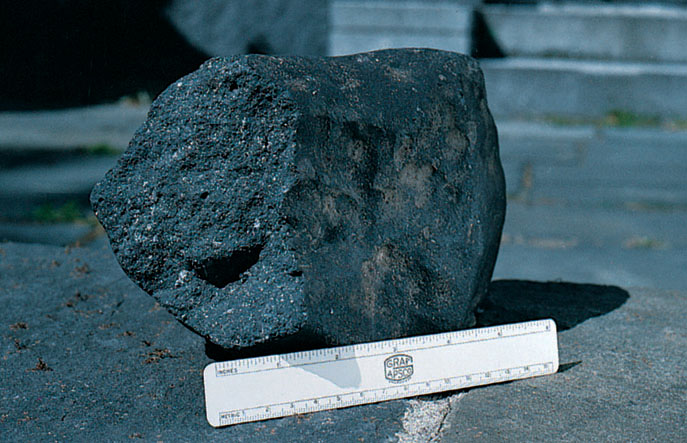15-6 Some meteorites retain traces of the early solar system
A class of rare stony meteorites called carbonaceous chondrites shows no evidence of ever having been melted while in space. As suggested by their name, carbonaceous chondrites contain substantial amounts of carbon and carbon compounds, including complex organic molecules and as much as 20% water bound into the minerals. These compounds would have been broken down and the water driven out if these meteorites had been subjected to heating and melting. Carbonaceous chondrites may therefore be samples of the original material from which our solar system was created. The asteroid 253 Mathilde, shown in Figure 15-7, has a very dark gray color and the same sort of spectrum as a carbonaceous chondrite. It, too, is likely composed of material that predates the formation of the solar system.
Amino acids, the building blocks of proteins upon which terrestrial life is based, are among the organic compounds occasionally found inside carbonaceous chondrites. Interstellar organic material has thus probably been falling on our planet since its formation. Some scientists suspect that carbonaceous chondrites may have provided some of the original building blocks in the development of life on Earth.

A Piece of the Allende Meteorite This carbonaceous chondrite fell near Chihuahua, Mexico, in February 1969. The meteorite’s dark color is due to its high abundance of carbon. Radioactive age-dating indicates that this meteorite is 4.56 billion years old, suggesting that this meteorite is a specimen of primitive planetary material that predates the formation of the planets. The ruler is 15 cm (6 in.) long.
Shortly after midnight on February 8, 1969, the night sky around Chihuahua, Mexico, was illuminated by a brilliant blue-white light moving across the heavens. As the light crossed the sky, it disintegrated in a spectacular, noisy explosion that dropped thousands of rocks and pebbles over terrified onlookers. Within hours, teams of scientists were on their way to collect specimens of a carbonaceous chondrite, collectively named the Allende meteorite after the locality (Figure 15-24).
Specimens were scattered in an elongated ellipse approximately 50 km long by 10 km wide. Most fragments were coated with a fusion crust, but minerals immediately beneath the crust showed no signs of damage. Surface material is peeled away as it becomes heated during flight through the atmosphere; this process forms the fusion crust. Because the heat has little time to penetrate the meteorite’s interior, compounds there are left intact.
One of the most striking discoveries to come from the Allende meteorite was evidence suggesting that a nearby star exploded into a supernova about 4.6 billion years ago. In a supernova, a massive star reaches the end of its life cycle and blows itself apart in a cataclysm that hurls matter outward at tremendous speeds (see Figure 1-8). During this detonation, violent collisions between nuclei produce a host of radioactive elements, including 26Al, a radioactive isotope of aluminum.
Researchers found clear evidence for the former presence of 26Al in the Allende meteorite: Chemical analyses revealed a high abundance of a stable isotope of magnesium (26Mg), which is produced by the radioactive decay of 26Al. Some astronomers interpret this as evidence for a supernova in our vicinity at about the time the Sun was born. Indeed, by compressing interstellar gas and dust, the supernova’s shock wave may have triggered the birth of our solar system.
CONCEPT CHECK 15-8
Why are carbonaceous chondrites thought to preserve some of the primal material that formed our solar system?
The buildup of larger objects in the formation of the solar system involved heating (due to radioactivity and collisions) leading to alteration of their chemical composition. However, the carbonaceous chondrites do not show chemical alteration that would have occurred if they were heated. Therefore, this class of meteorites appears to contain some original unaltered material present in the early solar nebula.